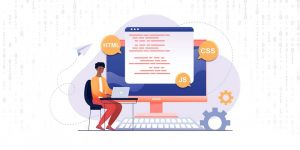Is Coding Hard for Kids? Learn Coding Fast With 5 Basic Concepts
- admin
- 2023-11-30
- 5 min read

They say learning to code is hard as it takes time, persistence, and resources. For instance, you will need a computer, not to mention a medium, or programming language, that you must learn. While learning a programming language doesn’t seem impossible, don’t think, even for a second, that it will be easy.
Designing software applications requires lots of creativity and a knack for problem-solving. So, you can only imagine the hard work of making software programs stand out.
What is even more mind-boggling is putting kids to the test. However, it is not as big a task as most people think it is as Coding is all about creativity, and young children have lots of it.
What does Coding mean for Kids?
Contents
Coding can mean many things to different people, but to kids, it may be the key to unlocking the doors to a new world. For instance, as suggested, developing software applications requires a medium or interface, and a programming language gives you that interface. A programming language is much like any other language, such as English. Kids are adept at learning new languages, owing to their enhanced brain plasticity, capable neural linking abilities, and minimal inhibitions.
Since the programming world consists of several languages, the challenge lies in figuring out where to begin. Several programming languages have come and gone over the years, but only a few of those are suitable for teaching kids to code. These programming interfaces may include:
1. Scratch
2. Python
3. Java
4. Lua
5. HTML
6. CSS
You can start with Scratch with five-year-olds since it is the easiest to grasp among the six languages mentioned here, consisting of only visual elements and no text. Once they get older and get the hang of Coding with Scratch, you can move to Python since it is also primarily visual-based and has limited text elements.
When your kids come of a certain age when they learn to read, you can teach them to code using programming languages like Java, or Lua, which find uses in developing video games and applications for platforms like Android.
The last two languages on the list, – HTML, and CSS, are for advanced programmers and use complex tags and syntax as part of their codes. Developers use these languages to create websites and Internet-based applications, and your kids should be able to learn them if they are at least ten years.
Basic Coding Concepts that Every Kid Should Know
Coding requires understanding a few basic concepts, and your kids can become lead programmers if you can teach them these five essential elements, without which it would be hard to design software applications.
1. Variables
Variables are the foundations of a computer program. They are ‘containers’ for holding or storing information. The information referred to here is the inputs you must provide to achieve your desired output.
Consider a simple example program where you want to add two numbers, say, ‘1’ and ‘2.’ Here, ‘1’ and ‘2’ are the variables that help you get the output, ‘3’ with the operator’s help, ‘+.’
Here, the variables, or inputs, can be any number that gives you the desired output.
2. Data Structures
Data structures allow programmers to collect and hold information much like variables. However, these containers can have more than one variable and help programmers save on storage space when they deal with large data sets.
For instance, let us say you want to add ten numbers. So, this would mean that you have ten variables as your input instead of only two, as in the previous case. Since adding ten variables becomes more tedious compared to only two, you can put them in a data set like a ‘list.’
3. Control Structures
So, now you have put ten variables in a data set. However, you will need to control how this data set works, to get the desired output, and this is where control structures come in to help.
Think of control structures as variables using which you can control how the computer executes programs. For instance, if you want your computer to add the ten numbers starting from ‘one’ onwards, you can use appropriate control structures associated with the operation.
However, you can do more with control structures, such as setting the rules – even strict ones.
For instance, let’s say you want to add numbers starting from one to ten. While you can start the operation with ‘one’ and go all the way up to ‘ten,’ it is also possible to start randomly. So, you can begin the process from, say, ‘five’ instead of ‘one’ with the help of control structures.
4. Syntax
All languages, including English, come with syntax, which are the rules that govern their usage. Likewise, computer languages also have a syntax based on which they work, ensuring the computer reads and interprets inputs accurately, so there are no errors in the output.
For instance, addresses used to locate a place almost always come in a definite format, where the building number comes first, and then the street number, name, the area or locality, and the city and country, not to mention a unique area code.
Likewise, every line of code also comes with a definite structure that is unique to the programming language using which you execute them. The syntax ensures that the commands run sequentially, and you get the expected output.
5. Tools
Most programming languages also come with handy tools that make coding and software development easy and hassle-free. These tools are software applications embedded into the interfaces and help execute commands faster. For example, most programming languages, such as C++, come with an Integrated Development Environment (IDE) that allows checking code and the syntax for errors, besides organizing files and auto-completing commands and their execution. IDEs also help quickly navigate through code lines and accurately streamline execution processes.
Final Thoughts
There is much speculation as to what age kids can learn to code. However, despite these contradicting views, children should still learn Coding, not only because of the increasing demand but also because it allows their creativity and problem-solving skills to unfold.
Learning to code helps kids get that competitive edge that allows them to understand how things work from different perspectives.
Moreover, Coding also teaches kids to become better problem solvers, not to mention communicators and inculcates in them a go-getter spirit. There is also the fun aspect that kids don’t miss out on while learning to apply logic and creativity.
21K School
Read our latest education blogs here. We are pioneers in proffering personalised, affordable and high-quality lessons using an advanced learning platform.


Join Asia’s Leading Online School and Unlock
endless opportunities
Join Asia’s
Leading Online School
and Unlock endless opportunities

 Thailand
Thailand




